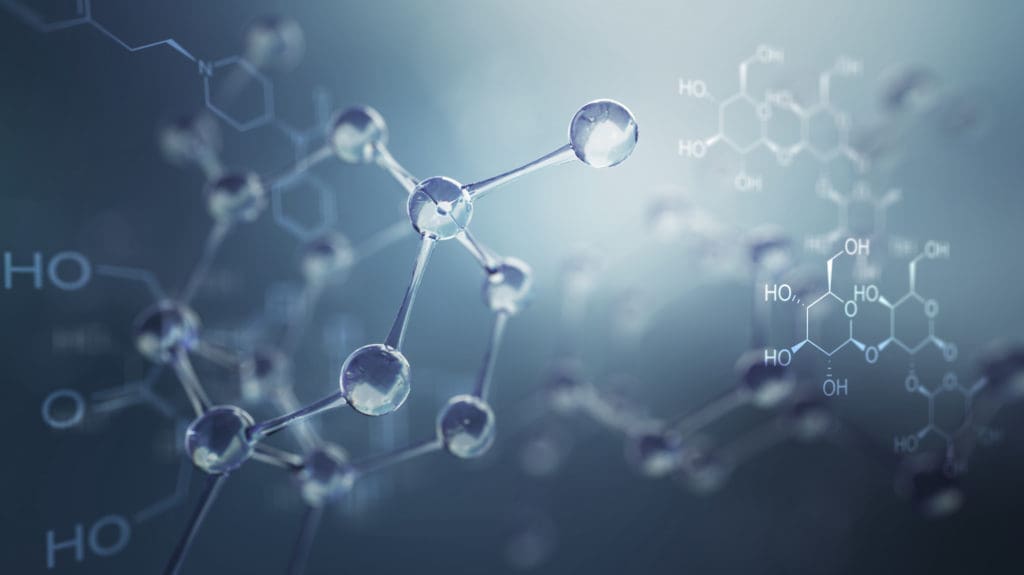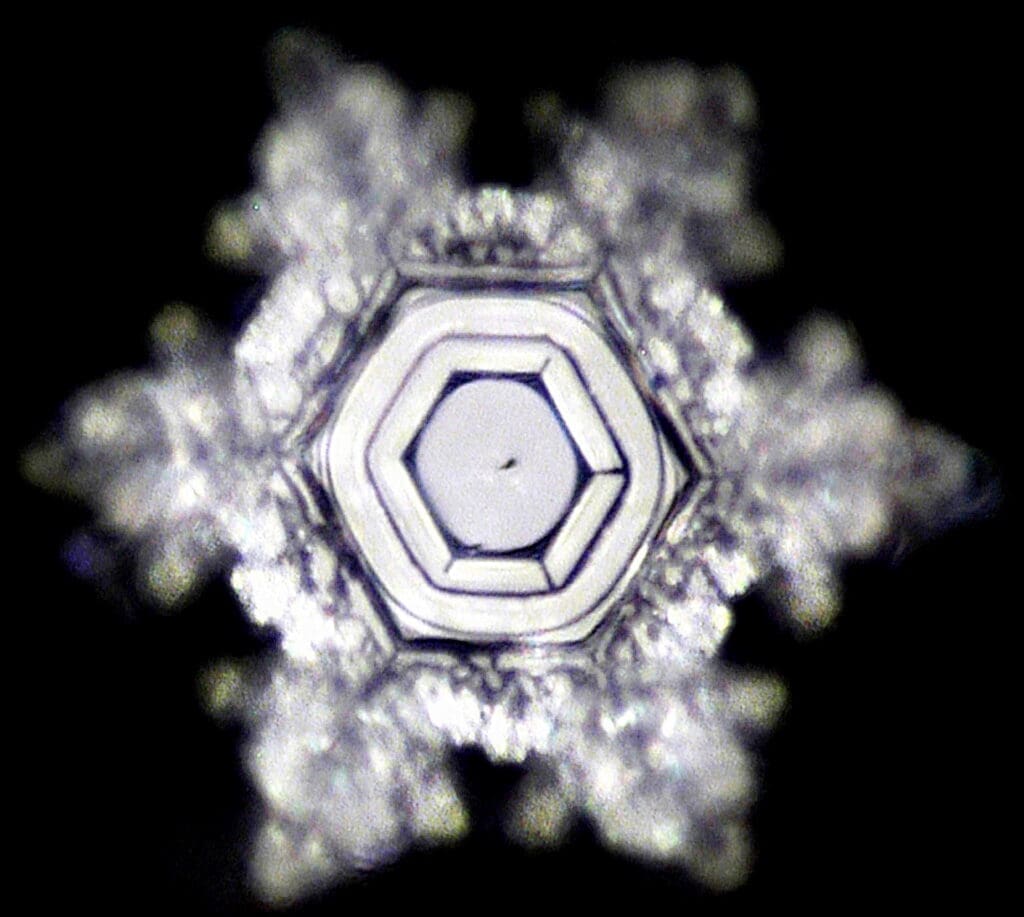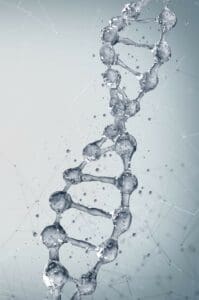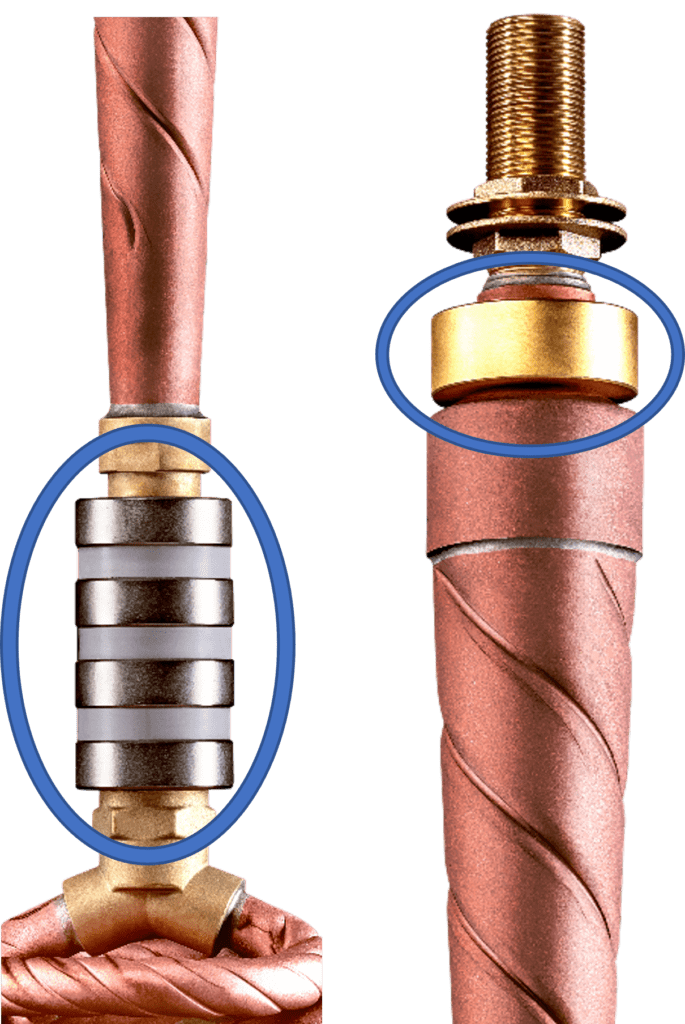
Illustration of the structure of water (hydrogen bonds)
The structure of water
- Liquid water is structured via hydrogen bridges in a three-dimensional network of water micro-clusters composed of 2 to 15 water molecules which are reorganised every picoseconds! The structure of water is therefore composed of different forms of ephemeral associations, but statistically sustainable! These micro-clusters of water produce dynamic polygonal shapes depending upon the energy passing through them and their mineral composition (= ionized salts, mainly calcium); the most natural, healthy and stable form of water is the hexagonal form (6 H2O molecules) according to Dr. Mu Shik Jhon!
- These liquid water micro-clusters will create macrostructures of +/- 1.400 water molecules via hydrogen bridges (= macro-clusters). It is on this scale that we would find the areas of phase coherence which would be composed of 10 to 30 million water molecules (according to Prof. M. Henry) which would oscillate at the same frequency (in synchronicity) and would transmit “information” to our DNA & proteins which would allow cellular communication and would even transmit this universal information to our consciousness! Water is an interface between energy and matter. “Energy codes, water decodes, humans encodes”!
- In the solid state (snow, crystals), natural water clusters can count up to a few hundred water molecules (-> +/- 600 H2O molecules ; Thomas Zeuch at the Institut für Physikalische Chemie in Göttingen, Germany vibrational spectroscopy analysis) organised most times around a hexagonal shape surrounded by 6 ramifications structured in multiple fractals (symmetrical and redundant superstructures), regular and harmonious (see study of water crystals)
Find out more :
The structure of dynamized water
Natural water is water that is structured from a molecular point of view. This structuring is possible thanks to the fact that the water molecule is a dipole (there is a potential difference between the Oxygen atom (negative charge) & Hydrogen atom (positive charge) which allows hydrogen bonds (or non-covalent bonds) between water molecules which are formed via their electrons (= waves & corpuscles). These molecular bonds are made not only between water molecules but also between these water molecules and other molecules (water is a solvent). These bonds represent the structure of water that forms clusters (aggregates) of molecules structured in dynamic polygonal shapes that differ according to the energy flowing through them. These chains of water molecules reorganize every picosecond! The structure of water is therefore composed of different forms of ephemeral associations, but statistically durable! The structuring of water seems to be influenced by the energy to which it is exposed.
This energy is found on the one hand in the ionized salts present in water (i.e. its minerals) and on the other hand in nature (either electromagnetic, magnetic, gravitational energy, etc.) which surrounds it.
It also seems that dynamized water is water that most often has a hexagonal structure (when observed in the form of a crystal) comparable to that of natural water that spontaneously springs from its source.
The hexagonal geometric structure of water appears to be the most consistent molecular form of it. This hexagonal structure would allow it to capture, decode and transmit energy frequencies (= information) which cross it (and which come from our environment) and which would play a role in cellular communication and therefore life! (see in this regard the works of Mu Shik Jon, Emilio Del Giudice, Jacques Benveniste, Marc Henry and Luc Montagnier). The structure of water is an interconnected liquid network that is a vector of information and a code reader that would allow the transmission and interpretation of bioelectric signals between cells.
Besides, water molecules adopt a chiral (mirror) helical structure due to their interaction with the spiral structure of DNA; A change in the molecular structure of water (via its stronger or weaker hydrogen bonds) around the DNA molecule, can lead to changes in the structure and function of DNA! ; Source: Steven A. Corcelli – Department of Chemistry and Biochemistry, University of Notre Dame, Notre Dame, Indiana, United States 2017
« Nothing is lost, nothing is created, everything is transformed » Antoine Lavoisier



It seems that dynamized water is water which has most times a hexagonal structure comparable to that of natural water which springs spontaneously from its source (this restructuring comes from movements & magnetism generated by the biodynamizer®)
This molecular structure of water would be an interface, an “information reader” and a “transmitter” of the natural energy (including the energy of the quantum vacuum) arounds us.
There is a strong interaction of energy (= mutual and amplified transfer of energy), between the kinetic energy of a swirling flux (= vortex) and the magnetic field emitted by permanent magnets; the lines of the swirls are hydrodynamic force lines. The electromagnetic force potential will be proportional to the potential of the swirling speeds and the power of the permanent magnets! The combination of these two forces will restructure the water.






